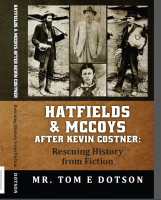In my first book I stated:
“The Hatfield and McCoy feud, as perceived by the general public, is a story that has become an industry. The participants in the industry, like their counterparts in other industries, seek growth. The growth needed to expand the revenue of the industry comes faster if the story itself grows. This growth is possible — and is occurring as I write — only because the feud is a story and not history.”
A recent example of the story’s growth is a post on the largest “Feud” Facebook site from a few days ago. The post begins with:
LOGAN, W.Va. — One historian stated in his writings that John Wesley Workman, shown here in a worn photograph, was a “loyal friend and strong supporter of the Hatfields” during the most violent period of the feud era, and may have rode with the Hatfields during several of their exploits.
Easy, isn’t it? One can find a name—any name– in the Logan County Census and say that he “may have rode (sic) with the Hatfields during several of their exploits,” and have as much real substantiation for the claim as this writer has for the quoted paragraph.
There is absolutely NO mention of a person named John Wesley Workman as an active participant in any event connected with “the feud” in any public record in any courthouse or state archive. Of course the writer knows this, and that is why he cites no documentary evidence, opting instead to cite an anonymous “historian.”
To the feud industry, a “historian” is anyone who has ever written a book or article that contains fictitious Hatfield and McCoy feud characters and events. Newspaper reporters, novelists and even barbers qualify for the title of “historian” in the feud industry.
The post has nearly one hundred Facebook “likes,” so the number of people who are gullible enough to believe that a man named John Wesley Workman was a major character in the Hatfield and McCoy feud is apparently very large, indeed. That population is definitely large enough to accommodate the continuing growth of the feud yarn for the foreseeable future.
